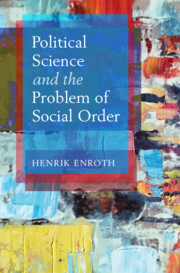Book contents
- Political Science and the Problem of Social Order
- Political Science and the Problem of Social Order
- Copyright page
- Dedication
- Contents
- Preface
- 1 The Problem of Social Order and the History of Political Science
- 2 Plurality and Unity
- 3 Processing Community
- 4 Bringing Community Back In
- 5 Conflict and Consensus
- 6 Support for the System
- 7 Questioning Consensus
- 8 Power and Participation
- 9 The Problem of Social Order and the Future of Political Science
- Bibliography
- Index
9 - The Problem of Social Order and the Future of Political Science
Published online by Cambridge University Press: 17 March 2022
- Political Science and the Problem of Social Order
- Political Science and the Problem of Social Order
- Copyright page
- Dedication
- Contents
- Preface
- 1 The Problem of Social Order and the History of Political Science
- 2 Plurality and Unity
- 3 Processing Community
- 4 Bringing Community Back In
- 5 Conflict and Consensus
- 6 Support for the System
- 7 Questioning Consensus
- 8 Power and Participation
- 9 The Problem of Social Order and the Future of Political Science
- Bibliography
- Index
Summary
In this concluding chapter, I first bring the story up to date by briefly considering influential developments since the 1990s, especially theories of governance and theories of group identity, which variously reiterate the problem of social order. I then argue that instead of positing, again and again, social order as a presupposition for political inquiry, social order should be turned into an object of political inquiry. To that end, I conclude, we may well need other conceptual and theoretical resources than those provided by the tradition of social science that is the subject of this book. Accepting the social ontology of complexity and diversity on which this tradition has been predicated does not compel us to keep relying on concepts and theories marked by the problem of social order.
- Type
- Chapter
- Information
- Political Science and the Problem of Social Order , pp. 164 - 177Publisher: Cambridge University PressPrint publication year: 2022

